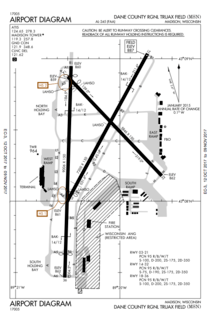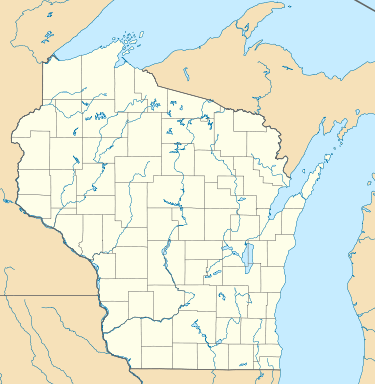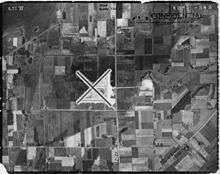Dane County Regional Airport
| Dane County Regional Airport Truax Field | |||||||||||||||||||
|---|---|---|---|---|---|---|---|---|---|---|---|---|---|---|---|---|---|---|---|
 Logo as of 2013 | |||||||||||||||||||
| Summary | |||||||||||||||||||
| Airport type | Public | ||||||||||||||||||
| Owner/Operator | Dane County | ||||||||||||||||||
| Serves | Madison, Wisconsin | ||||||||||||||||||
| Location | Madison, Wisconsin | ||||||||||||||||||
| Elevation AMSL | 887 ft / 270 m | ||||||||||||||||||
| Coordinates | 43°08′23″N 089°20′15″W / 43.13972°N 89.33750°W | ||||||||||||||||||
| Website |
msnairport | ||||||||||||||||||
| Maps | |||||||||||||||||||
 Airport Diagram | |||||||||||||||||||
 MSN Location of airport in Wisconsin  MSN MSN (the US) | |||||||||||||||||||
| Runways | |||||||||||||||||||
| |||||||||||||||||||
| Statistics | |||||||||||||||||||
| |||||||||||||||||||
- For the Air National Guard use of this facility, see Truax Field Air National Guard Base.
Dane County Regional Airport (DCRA) (IATA: MSN, ICAO: KMSN, FAA LID: MSN) (Truax Field) is a civil-military airport located six miles northeast of downtown Madison, the capital of Wisconsin.[2] In the Federal Aviation Administration (FAA) National Plan of Integrated Airport Systems for 2019–2023, it is categorized as a small-hub primary commercial service facility.[3] It is the second busiest of eight commercial airports in Wisconsin in terms of passengers served.
DCRA has three runways and in 2016 it served more than 1.8 million passengers. MSN serves American, Delta, Frontier and United. Sun Country will be starting service to DCRA soon. These airlines have non-stop flights to fifteen hubs with over 95 departures and arrivals daily to and from destinations such as Atlanta, New York City, Orlando, Salt Lake City, Washington DC, Charlotte, and San Francisco. Delta and United provide service with Airbus A319s and A320s as well as Boeing 737s and 757s which are among the largest aircraft operating at the airport. Frontier has introduced the Airbus A320neo to the airport, an aircraft with one of the quietest engines in the US commercial fleet.
History
The airport was renamed Truax Field and activated as a U.S. Army Air Corps airfield in June 1942 during World War II. During the war, it was used by the Army Air Corps Eastern Technical Training Center, a major school operating at Truax AAF for training radio operators and mechanics, and later expanded to training in radar operations, control tower operations, and other communications fields for the Army Airways Communication Service. A unit established in 1943 trained radio operators and mechanics on B-29 Superfortress communications equipment. The host unit on the airfield was the 334th (later 3508th) Army Air Corps Base Unit. On September 17, 1945, the airfield's mission was changed to that of a separation center and it was closed as an active AAF airfield on November 30, 1945.
Conveyed to local civil authorities, the Madison Municipal Airport became the home to the 1st Battalion 147th Aviation Regiment. The 1-147th operates the UH-60M Blackhawk Helicopter and has deployed in support of Operation Enduring Freedom. The airport is also home to the Wisconsin Air National Guard and its present-day 115th Fighter Wing (115 FW), an Air National Guard fighter wing operationally-gained by the Air Combat Command (ACC). Today, the Air National Guard's F-16 Fighting Falcon still operates at the base. The 115th Fighter Wing is one of the 14 operational air defense units responsible for air defense of the eastern continental United States.
On December 15, 1966, a 31,000 square foot terminal building opened on the west side of the airfield at a cost of $2.36 million. In 1986, the airport tripled in size with a $12 million project that expanded the terminal from 32,000 square feet to 90,000 square feet, adding a second level concourse with six boarding bridges.[4]
In 2006, the airport completed a $68 million expansion that doubled the size of the terminal, built in a Frank Lloyd Wright-influenced prairie style designed by the Architectural Alliance based in Minneapolis.[5] The new terminal accommodates 13 gates with jetways, WiFi, additional restaurant and retail vendors post-security, an art court, and both business and family lounges. The airport has also continued to expand its parking options, most recently in 2014.
On February 7, 2018, the airport announced a significant terminal modernization program, including replacement of existing jet bridges and design work beginning in 2018, and major construction including additional jet boarding bridges beginning in 2019.[6] The county is also planning to add an 8 MW solar energy site on airport-owned land.[7]
Facilities and aircraft
Dane County Regional Airport covers 3,500 acres (1,416 ha) with a field elevation of 887 feet (270 m) above mean sea level. It has three concrete runways: 18/36 is 9,006 by 150 feet (2,745 x 46 m); 3/21 is 7,200 by 150 feet (2,195 x 46 m); 14/32 is 5,846 by 150 feet (1,782 x 46 m).[2]
The fixed-base operator (FBO) is Wisconsin Aviation,[8] which leased the assets of the former FBO, Four Lakes Aviation and Coldstream Aviation, in 1994.
More recent data shows the following operations annually for the last eight years:[9]
| 2009: | 96,700 |
| 2010: | 96,205 |
| 2011: | 83,263 |
| 2012: | 82,777 |
| 2013: | 84,860 |
| 2014: | 78,956 |
| 2015: | 78,206 |
| 2016: | 81,419 |
In 1927, the City of Madison purchased 290 acres of land for $35,380. Previously a cabbage patch for a nearby sauerkraut factory, the newly acquired land would later become the present day home of the Dane County Regional Airport. In January 1936, the city council voted to accept a Works Progress Administration grant for construction of four runways and an airplane hangar. Additional grants financed the terminal and administrative building as well as electric floodlights. The development price tag was $1,000,000 – 10% paid by the city and remainder by the federal government (MSN Airport, 2012). In September 1938, Barnstormer Howard Morey of Chicago, Edgar Quinn and J.J. McMannamy organized the Madison Airways Corporation.
In 1942, operation of the airfield was also transferred to the US Army Air Corps. The airfield was renamed Truax Field in honor of Madisonian Lt. Thomas L. Truax who died in a training flight shortly before the attack on Pearl Harbor. Twenty years later in 1962, the city completed a long-range master plan – paving the way for a grant from the Federal Aid to Airports Program – a new terminal and taxiway system was designed. This would be the first expansion of the airport. By 1968, the US Air Force was completely phased out of Truax field, leaving the Wisconsin Air National Guard to perform alert/interceptor mission exclusively. 770 acres of land and many buildings were deeded to the city.

In 1974, jet service began through Northwest Orient Airlines and averaged over 500,000 passengers per year. In 1986, the terminal tripled in size with a $12 million project that expanded the terminal from 32,000 square feet to 90,000 square feet, adding a second level concourse with six boarding bridges.
In 1991, a $3.8 million expansion added a 50-foot high glass atrium and a commuter gate concourse – expanding the terminal to over 125,000 square feet. A multi-level parking structure was built in 1993 with an additional level added in 1998. In 2000, a groundbreaking ceremony initiated a phase 1 of a 6-year, $68 million building project that doubled the size of the terminal to 274,000 square feet.
In 2002, Wisconsin Aviation dedicated a new general aviation terminal on the east ramp.
In 2006, Robert Skuldt, airport director for 34 years, was inducted into the Wisconsin Aviation Hall of Fame. The executive conference room on the main level was dedicated in his honor.
In 2009, the airport received $4 million in stimulus dollars to expand taxiway B to the south end of runway 18-36.[10] The taxiway is primarily used by Wisconsin Air National Guard aircraft and also allows private jets to return to the fixed-base operator without having to hold on taxiway A to cross the main runway.
In September 2014, a new 58,000 square-foot snow removal equipment building opened. At the time, it housed the largest municipal solar array in Wisconsin.[11] An expansion of the airport parking structure was completed in 2014 at a cost of $30 million.[12][13] In late fall 2016, a Category II instrument landing system and other systems to facilitate low visibility landings began operating.[14]
2016 marked a record-breaking year for the highest passenger traffic for the airport with 1,841,809 departing and arriving passengers. The second-best year was 2004.
In October 2018, there were 156 aircraft based at this airport: 75 single-engine, 18 multi-engine, 26 jet, 1 helicopter and 36 various military aircraft.[2]
The interior of the airport boasts five restaurants for patrons to choose from, along with four shops.
Airlines and destinations
Passenger
| Airlines | Destinations | Refs |
|---|---|---|
| American Eagle | Charlotte, Chicago–O'Hare, Dallas/Fort Worth, Philadelphia
Seasonal: Phoenix-Sky Harbor (begins January 6, 2019)[15] | [16] |
| Delta Air Lines | Atlanta, Detroit, Minneapolis/St. Paul | [17] |
| Delta Connection | Detroit, Minneapolis/St. Paul, New York–LaGuardia, Salt Lake City, Washington–National | [17] |
| Frontier Airlines | Denver, Las Vegas Seasonal: Orlando, Philadelphia, Phoenix-Sky Harbor (begins November 17, 2018)[18] | [19] |
| Sun Country Airlines | Seasonal: Fort Myers, Tampa | [20] |
| United Airlines | Chicago–O'Hare, Denver | [21] |
| United Express | Chicago–O'Hare, Denver, Newark, San Francisco | [21] |
| Destinations map |
|---|
 Madison All passenger destinations from Dane County Regional Airport (MSN). (Red) = Year-round Destination (Green) = Seasonal Destination (Blue) = Future Destination |
Cargo
| Airlines | Destinations |
|---|---|
| FedEx Express | Appleton, Cedar Rapids/Iowa City, Des Moines, Indianapolis, Memphis, Mosinee, Sioux Falls |
| Freight Runners Express | Milwaukee, Wisconsin Dells |
Statistics
Carrier shares
| Carrier | Passengers (arriving and departing) |
|---|---|
| Delta | 595,000(31.04%) |
| SkyWest | 330,000(17.21%) |
| United | 276,000(14.41%) |
| Envoy Air | 180,000(9.39%) |
| Frontier | 117,000(6.09%) |
| Other | 419,000(21.86%) |
Top destinations
| Rank | Airport | Passengers | Carriers |
|---|---|---|---|
| 1 | Chicago–O'Hare, Illinois | 211,430 | American, United |
| 2 | Minneapolis/St. Paul, Minnesota | 152,360 | Delta |
| 3 | Detroit, Michigan | 144,430 | Delta |
| 4 | Atlanta, Georgia | 115,640 | Delta |
| 5 | Denver, Colorado | 105,740 | Frontier, United |
| 6 | Dallas/Ft. Worth, Texas | 63,520 | American |
| 7 | Charlotte, North Carolina | 41,600 | American |
| 8 | New York–La Guardia, New York | 27,390 | Delta |
| 9 | Newark, New Jersey | 25,550 | United |
| 10 | Las Vegas, Nevada | 19,140 | Frontier |
Ground Transportation
Taxi service and Transportation Network Company drivers (e.g. Uber and Lyft) is available outside the terminal. Rental car counters are located across from the baggage claim area. In addition, many local hotels provide courtesy shuttle service to and from the airport.
Madison Metro serves the airport with Route 20, to the North Transfer Point or Madison Area Technical College / East Towne Mall.[23]
Both short and long-term parking is available in a large parking structure and in several adjacent lots.[24]
References
- ↑ Dane County Regional Airport, official web site
- 1 2 3 4 FAA Airport Master Record for MSN (Form 5010 PDF), effective October 11, 2018.
- ↑ "NPIAS Report 2019-2023 Appendix A" (PDF). Federal Aviation Administration. October 3, 2018. Retrieved October 12, 2018.
- ↑ History Of The Dane County Regional Airport Archived 2012-05-04 at the Wayback Machine.
- ↑ "Dane County Regional Airport Opens to Rave Reviews". Archalliance.com. Retrieved 2017-06-26.
- ↑ "After Busiest Year In Its History, Airport Plans for Terminal Modernization". www.msnairport.com. Retrieved 2018-02-07.
- ↑ Journal, Bill Novak | Wisconsin State. "Massive solar energy site to provide power to Dane County Regional Airport". madison.com. Retrieved 2018-03-06.
- ↑ Wisconsin Aviation, the airport's fixed-base operator (FBO)
- ↑ Air Traffic Activity System (ATADS). (2010). ATADS: Airport operations: Standard report. Retrieved from http://aspm.faa.gov/opsnet/sys/opsnet-server-x.asp
- ↑ "Stimulus Gives $4M for Dane County Airport Taxiway". The Capital Times. March 30, 2009.
- ↑ "Wisconsin's Largest Municipal Solar Array Completed - Dane County Press Releases". www.countyofdane.com. Retrieved 2018-02-19.
- ↑ Ivey, Mike (October 8, 2013). "Epic Systems driving $30 million parking expansion at airport". The Capital Times.
- ↑ "Parking Expansion Construction Project Begins". msnairport.com. May 6, 2014.
- ↑ "Airport To Secure Funding For Precision Instrument Approach". msnairport.com. June 16, 2014.
- ↑ http://www.wkow.com/story/39071464/2018/09/Tuesday/american-airlines-adds-a-new-madison-to-phoenix-non-stop-flight
- ↑ "Flight schedules and notifications". Retrieved 5 February 2017.
- 1 2 "DELTA FLIGHT SCHEDULES". Retrieved 5 February 2017.
- ↑ "Frontier Airlines schedules new routes in W18". Routes Online. August 2018. Retrieved August 15, 2018.
- ↑ "Route Map-Frontier Airlines". Frontier Airlines. Retrieved 5 February 2017.
- ↑ "Sun Country Airlines comes to Madison; non-stop service to Florida starts in September | Local News". host.madison.com. 1970-01-01. Retrieved 2018-06-26.
- 1 2 "Timetable". Retrieved 5 February 2017.
- 1 2 "RITA BTS Transtats - MSN". www.transtats.bts.gov. Bureau Of Transportation Statistics. Retrieved 23 September 2018.
- ↑ "Route 20 - Metro Transit - City of Madison, Wisconsin". www.cityofmadison.com. Retrieved 2018-05-02.
- ↑ "Parking & Transportation". www.msnairport.com. Retrieved 2018-05-02.
External links
| Wikimedia Commons has media related to Dane County Regional Airport. |
- Dane County Regional Airport:
- Wisconsin Airport Directory: Dane County Regional Airport (PDF)
- 115th Fighter Wing, Wisconsin Air National Guard
- LiveATC.net: Class C airports - Listen live to Madison's Air Traffic Control
- FAA Airport Diagram (PDF), effective October 11, 2018
- FAA Terminal Procedures for MSN, effective October 11, 2018
- Resources for this airport:
- AirNav airport information for KMSN
- ASN accident history for MSN
- FlightAware airport information and live flight tracker
- NOAA/NWS latest weather observations
- SkyVector aeronautical chart for KMSN
- FAA current MSN delay information